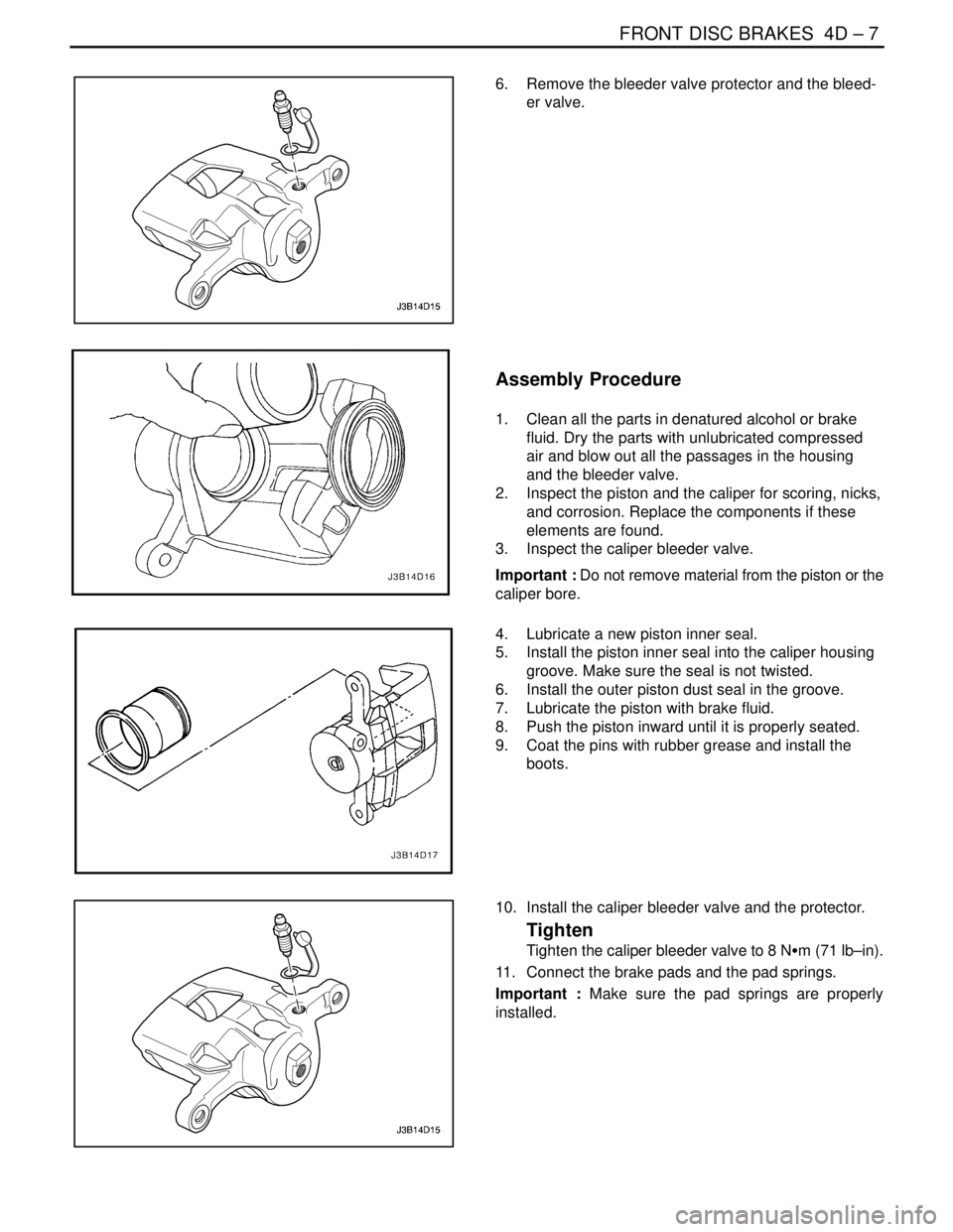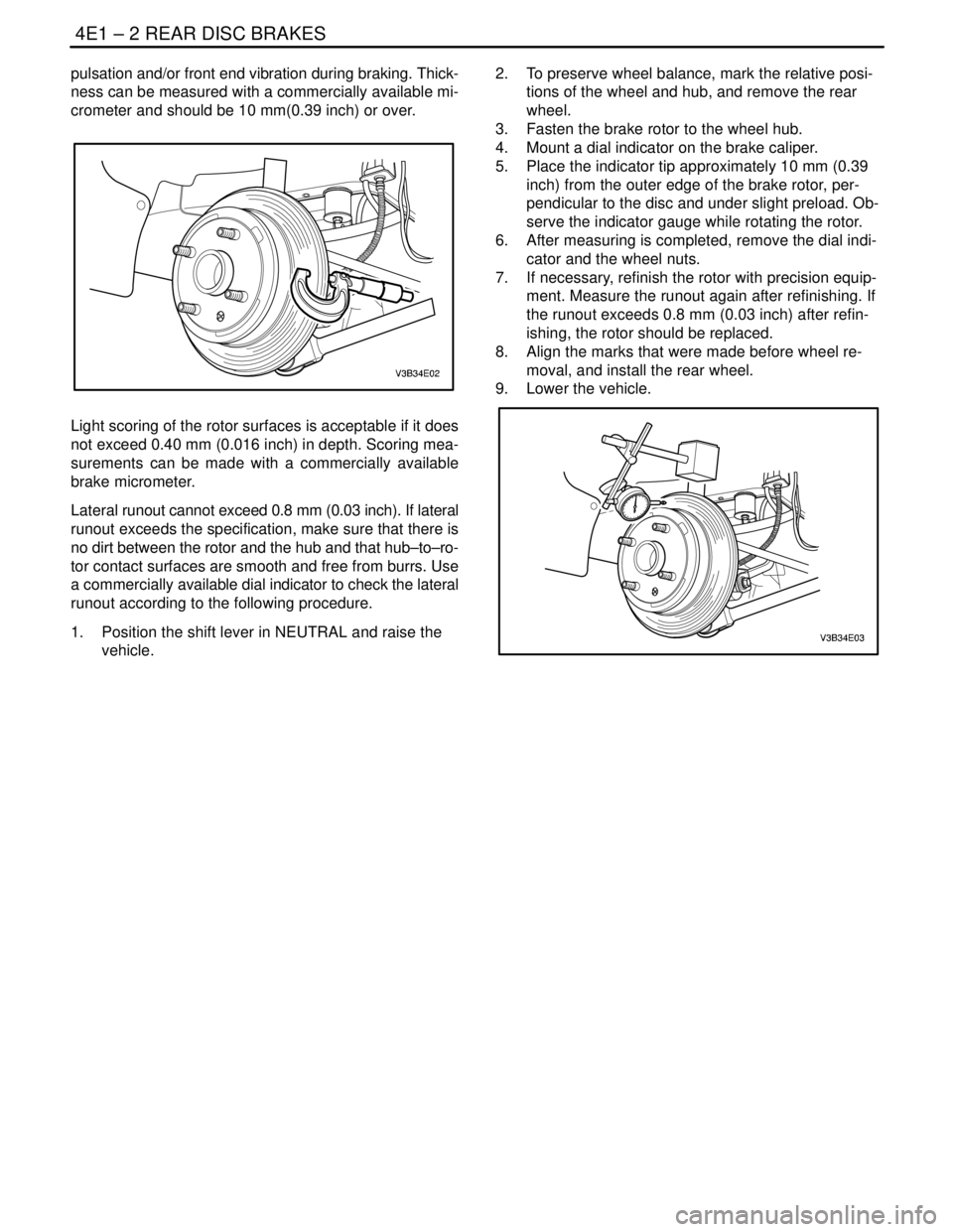Page 1055 of 2643

FRONT DISC BRAKES 4D – 7
DAEWOO V–121 BL4
6. Remove the bleeder valve protector and the bleed-
er valve.
Assembly Procedure
1. Clean all the parts in denatured alcohol or brake
fluid. Dry the parts with unlubricated compressed
air and blow out all the passages in the housing
and the bleeder valve.
2. Inspect the piston and the caliper for scoring, nicks,
and corrosion. Replace the components if these
elements are found.
3. Inspect the caliper bleeder valve.
Important : Do not remove material from the piston or the
caliper bore.
4. Lubricate a new piston inner seal.
5. Install the piston inner seal into the caliper housing
groove. Make sure the seal is not twisted.
6. Install the outer piston dust seal in the groove.
7. Lubricate the piston with brake fluid.
8. Push the piston inward until it is properly seated.
9. Coat the pins with rubber grease and install the
boots.
10. Install the caliper bleeder valve and the protector.
Tighten
Tighten the caliper bleeder valve to 8 NSm (71 lb–in).
11. Connect the brake pads and the pad springs.
Important : Make sure the pad springs are properly
installed.
Page 1056 of 2643
4D – 8IFRONT DISC BRAKES
DAEWOO V–121 BL4
12. Connect the retaining frame to the caliper housing
with the guide pin bolts.
Tighten
Tighten the retaining frame–to–caliper housing bolts
to 27 NSm (20 lb–ft).
13. Install the caliper assembly. Refer to ”Caliper As-
sembly” in this section.
Page 1057 of 2643

FRONT DISC BRAKES 4D – 9
DAEWOO V–121 BL4
GENERAL DESCRIPTION
AND SYSTEM OPERATION
DISC BRAKE CALIPER ASSEMBLY
This caliper has a single bore and is mounted to the steer-
ing knuckle with two mounting bolts. Hydraulic pressure,
created by applying the brake pedal, is converted by the
caliper to a stopping force. This force acts equally against
the piston and the bottom of the caliper bore to move the
piston outward and to slide the caliper inward, resulting in
a clamping action on the rotor. This clamping action forces
the linings against the rotor, creating friction to stop the ve-
hicle.Important :
S Replace all components included in the repair kits
used to service this caliper.
S Lubricate the rubber parts with clean brake fluid to
ease assembly.
S Do not use lubricated shop air on brake parts, as
damage to the rubber components may result.
S If any hydraulic component is removed or discon-
nected, it may be necessary to bleed all or part of
the brake system.
S Replace the pads in axle sets only.
S The torque values specified are for dry, unlubri-
cated fasteners.
S Perform the service operations on a clean bench,
free from all mineral oil materials.
Page 1058 of 2643

SECTION : 4E1
REAR DISC BRAKES
TABLE OF CONTENTS
SPECIFICATIONS4E1–1 . . . . . . . . . . . . . . . . . . . . . . . . .
Fastener Tightening Specifications 4E1–1. . . . . . . . . .
DIAGNOSIS4E1–1 . . . . . . . . . . . . . . . . . . . . . . . . . . . . . . .
Lining Inspection 4E1–1. . . . . . . . . . . . . . . . . . . . . . . . .
Rotor Inspection 4E1–1. . . . . . . . . . . . . . . . . . . . . . . . . .
MAINTENANCE AND REPAIR4E1–3 . . . . . . . . . . . . . .
ON–VEHICLE SERVICE 4E1–3. . . . . . . . . . . . . . . . . . . .
Shoe and Lining 4E1–3. . . . . . . . . . . . . . . . . . . . . . . . . . Caliper 4E1–4. . . . . . . . . . . . . . . . . . . . . . . . . . . . . . . . . .
Rotor 4E1–5. . . . . . . . . . . . . . . . . . . . . . . . . . . . . . . . . . .
Hub and Parking Brake Shoe/Backplate 4E1–6. . . . .
UNIT REPAIR 4E1–10. . . . . . . . . . . . . . . . . . . . . . . . . . . .
Caliper Overhaul 4E1–10. . . . . . . . . . . . . . . . . . . . . . . .
GENERAL DESCRIPTION AND SYSTEM
OPERATION4E1–12 . . . . . . . . . . . . . . . . . . . . . . . . . . . .
Disc Brake Caliper Assembly 4E1–12. . . . . . . . . . . . . .
SPECIFICATIONS
FASTENER TIGHTENING SPECIFICATIONS
ApplicationNSmLb–FtLb–In
Brake Hose Inlet Bolt and Ring Seals3224–
Caliper Mounting Bolts5641–
Lower Caliper Mounting Bolt2720–
Parking Brake Shoe Hold–Down Spring As-
sembly Screw4–35
Rotor Detent Screw4–35
Hub Bolts6548–
DIAGNOSIS
LINING INSPECTION
1. Raise and suitably support the vehicle.
2. Remove the rear wheels. Refer to Section 2E, Tires
and Wheels.
3. Visually check the brake shoe linings for minimum
thickness and wear.
4. Measure the thickness.
Important : The minimum discard thickness of the brake
shoe lining is 2 mm (0.08 inch).
5. Install the shoes in axle sets only.
6. Install the rear wheels. Refer to Section 2E, Tires
and Wheels.
7. Lower the vehicle.
ROTOR INSPECTION
Brake rotors are manufactured with close tolerances for
thickness variation, flatness, and lateral runout, but pits
and grooves are created in rotors during usage. Lack of
uniformity of the braking surfaces of the rotor can cause
inadequate braking and a pulsating pedal during braking.
The surface finish of the rotor is also important because
an unsuitable surface finish can cause pulling and rapid
wear of the brake shoe lining. If a rotor does not meet the
specification, it should be refinished to specification or re-
placed. Refinishing of the rotor should only be done with
precision equipment.
Thickness variation can be checked by measuring the
thickness of the rotor at four or more points around the cir-
cumference of the rotor. All measurements must be made
at the same distance from the edge of the rotor. A rotor that
varies by more than. 1.0 mm (0.04 inch) can cause pedal
Page 1059 of 2643

4E1 – 2IREAR DISC BRAKES
DAEWOO V–121 BL4
pulsation and/or front end vibration during braking. Thick-
ness can be measured with a commercially available mi-
crometer and should be 10 mm(0.39 inch) or over.
Light scoring of the rotor surfaces is acceptable if it does
not exceed 0.40 mm (0.016 inch) in depth. Scoring mea-
surements can be made with a commercially available
brake micrometer.
Lateral runout cannot exceed 0.8 mm (0.03 inch). If lateral
runout exceeds the specification, make sure that there is
no dirt between the rotor and the hub and that hub–to–ro-
tor contact surfaces are smooth and free from burrs. Use
a commercially available dial indicator to check the lateral
runout according to the following procedure.
1. Position the shift lever in NEUTRAL and raise the
vehicle.2. To preserve wheel balance, mark the relative posi-
tions of the wheel and hub, and remove the rear
wheel.
3. Fasten the brake rotor to the wheel hub.
4. Mount a dial indicator on the brake caliper.
5. Place the indicator tip approximately 10 mm (0.39
inch) from the outer edge of the brake rotor, per-
pendicular to the disc and under slight preload. Ob-
serve the indicator gauge while rotating the rotor.
6. After measuring is completed, remove the dial indi-
cator and the wheel nuts.
7. If necessary, refinish the rotor with precision equip-
ment. Measure the runout again after refinishing. If
the runout exceeds 0.8 mm (0.03 inch) after refin-
ishing, the rotor should be replaced.
8. Align the marks that were made before wheel re-
moval, and install the rear wheel.
9. Lower the vehicle.
Page 1060 of 2643
REAR DISC BRAKES 4E1 – 3
DAEWOO V–121 BL4
MAINTENANCE AND REPAIR
ON–VEHICLE SERVICE
SHOE AND LINING
Removal Procedure
1. Raise and suitably support the vehicle.
2. Remove the rear wheels. Refer to Section 2E, Tires
and Wheels.
3. Remove the lower caliper guide pin bolt.
Important : Caliper removal is not necessary to service
the brake pads.
4. Pivot the caliper upward.
5. Remove the brake shoes.
Installation Procedure
1. Measure the minimum brake shoe lining thickness.
Refer to ”Lining Inspection” in this section.
2. Install the brake shoes into the caliper.
3. Push the piston inward, if needed.
Page 1061 of 2643
4E1 – 4IREAR DISC BRAKES
DAEWOO V–121 BL4
Notice : Avoid damaging the piston seal when the piston
housing is pulled down.
4. Pivot the caliper downward and install the bolt.
Tighten
Tighten the lower caliper mounting bolt to 27 NSm (20
lb–ft).
5. Install the rear wheels. Refer to Section 2E, Tires
and Wheels.
6. Lower the vehicle.
CALIPER
Removal Procedure
1. Raise and suitably support the vehicle.
2. Mark the position of the rear wheels relative to the
wheel hubs and remove the wheels. Refer to Sec-
tion 2E, Tires and Wheels.
3. Remove the bolt and the ring seals that attach the
brake hose inlet fitting to the caliper.
4. Disconnect the brake hose. Plug the openings in
the caliper and the brake hose to prevent fluid loss
or contamination.
5. Remove the caliper mounting bolts from the steer-
ing knuckle.
6. Remove the caliper.
Installation Procedure
1. Install the caliper with the mounting bolts.
Tighten
Tighten the caliper mounting bolts to 56 NSm (41 lb–
ft).
Page 1062 of 2643
REAR DISC BRAKES 4E1 – 5
DAEWOO V–121 BL4
2. Connect the brake hose with the bolt and ring
seals.
Tighten
Tighten the brake hose inlet bolt and ring seals to 32
NSm (24 lb–ft).
3. Install the rear wheels. Refer to Section 2E, Tires
and Wheels.
4. Lower the vehicle.
5. Fill the master cylinder to the proper level with
clean brake fluid.
6. Bleed the caliper. Refer to Section 4F, Antilock
Brake System and Traction Control System.
ROTOR
Removal Procedure
1. Remove the caliper. Refer to ”Caliper” in this sec-
tion.
2. Remove the brake shoes.
3. Remove the caliper mounting bracket.
4. Remove the rotor detent screw.
5. Remove the rotor.
Installation Procedure
Important : To guarantee uniform braking, always refinish
both rotors even if only one rotor is defective.
1. Install the rotor on the front wheel hub and install
the detent screw.
Tighten
Tighten the rotor detent screw to 4 NSm (35 lb–in)